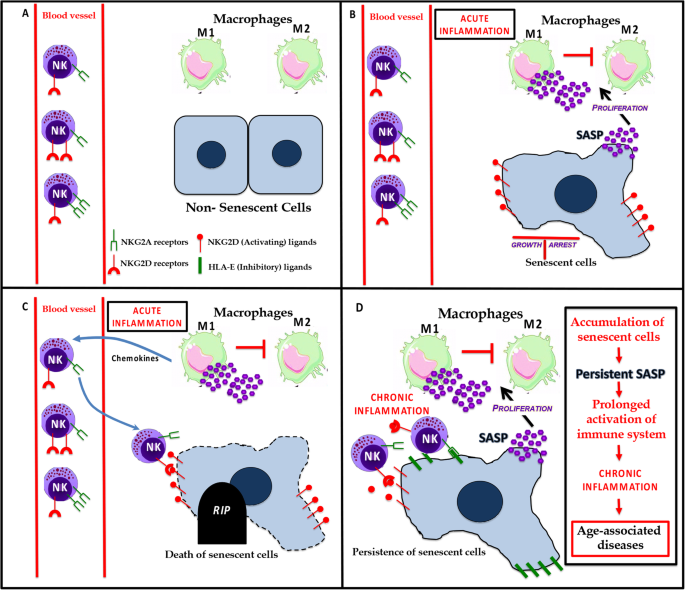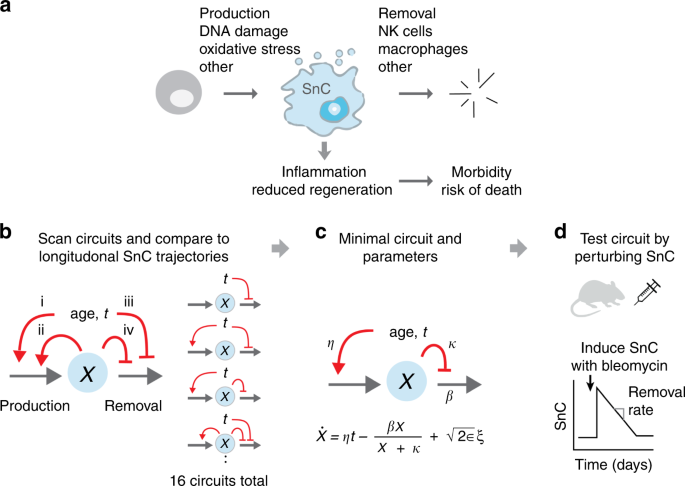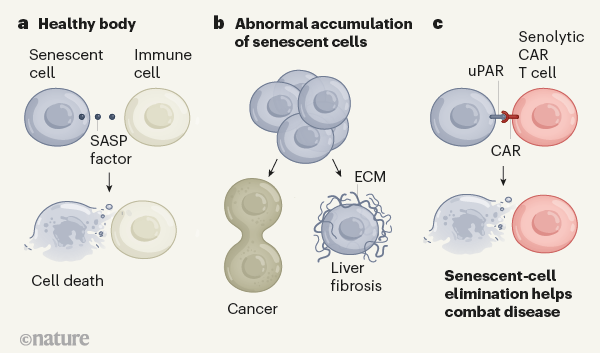Senescent Cells Removal
The result was eye-popping life extension in the mice that had their senescent cells removed. However a recent study has put this i.
 Debilities Of Aging Reversed By Protein That Targets Senescent Cells
Debilities Of Aging Reversed By Protein That Targets Senescent Cells
Senescent cells tend to accumulate in the brain with age.

Senescent cells removal. When aging cells permanently stop dividing thus preventing the propagation of damaged and. This study which also investigates the potential of senolytics in clearing senescent cells showed that pulmonary organ function was improved in transgenic studies as a result of the senolytics treatment given. Senescent cells are those cells in the body that have ignored the order to expire.
This review focuses on this possible use of immune cells and discusses how current cell-based therapies could be used for senescent cell removal. Scientists proclaim this senescent cell-removing technique might transform medicine as we know it. 20 to 25 increase in life span from a single treatment fairly late in life ref.
Anzeige Fluorescent detection of β- galactosidase hydrolysis by flow cytometry and imaging. There are currently under development or approved several immune cell-based therapies for cancer which could be redesigned to target senescent cells. Researchers Xu et al.
The results of these tests using senolytic drugs in aging mice appear in Aging Cell. When they treated mice with diet-induced. Showed in 2018 that senescent cells weaken the body.
Recent data suggest that the prolonged presence of senescent cells and especially the SASP could be deleterious and their beneficial effects early in life can become maladaptive such that they drive aging phenotypes and pathologies late in life. Senescent cells normally destroy themselves via a programmed process called apoptosis and they are also removed by the immune system. Senolytic compounds can selectively remove senescent cells by reactivating cells normal ability to die off gracefully.
Anzeige Fluorescent detection of β- galactosidase hydrolysis by flow cytometry and imaging. Studies have shown that removing senescent cells can alleviate symptoms of aging. Just a decade ago such discoveries would remain languishing in the lab for a maddeningly-long time.
Senolytic compounds have extended the median post-treatment lifespans of mice by as much as 36 while also reducing their risk of dying by 65. Senescent cells are damaged cells that are still living. Additionally the removal of senescent cells has been identified to improve brain function in mouse models of neurodegenerative diseases such as AD and ALS.
A new study shows that removing zombie cells also known as senescent aging or deteriorating cells from the body has the potential to slow down or. Unity Biotechnology believes the elimination of senescent cells will remove SASP factors see definition above addressing a root cause of diseases of aging. Senescent Cell Removal Energetically Programmed Audio Watch later.
Senescent cells accumulate in humans and secrete toxic inflammatory factors. Mayo Clinic research findings indicate that the removal of senescent cells in aging mice improves cognitive ability in animals that already show signs of dementia. Senescent cells are one of the root causes of aging and disease.
However the immune system weakens with age and increasing numbers of senescent cells escape this process and begin to accumulate in. Senescent cells accumulate with age. To do this their focus is on Senolytic medicines medicines believed to able to halt or reverse particular diseases of aging.
Several animal and human studies by the Mayo Clinic showed that removal of senescent cells can extend life. Senescent Cell Removal Energetically Programmed Audio - YouTube. Senescence is a response to cell damage and stress characterized by the arrest of the cell cycle.
The scientific team found they could remove senescent cells by using lipid antigens to activate iNKT cells. In a startling discovery published in July 2018 old animals lived 36 longer and regained physical function when senescent cells were removed. The removal of senescent cells in a bleomycin-injury idiopathic pulmonary fibrosis model using senolytics has been found to improve lung function in a study by Schafer et al 2017.
It is therefore important to develop strategies to eliminate senescent cells.
 Role Of Immune Cells In The Removal Of Deleterious Senescent Cells Immunity Ageing Full Text
Role Of Immune Cells In The Removal Of Deleterious Senescent Cells Immunity Ageing Full Text
 Clearance Of Senescent Cells And Therapeutic Options Cellular Download Scientific Diagram
Clearance Of Senescent Cells And Therapeutic Options Cellular Download Scientific Diagram
 Suicide Of Aging Cells Prolongs Life Span In Mice Science Aaas
Suicide Of Aging Cells Prolongs Life Span In Mice Science Aaas
 Senescent Cell Turnover Slows With Age Providing An Explanation For The Gompertz Law Nature Communications
Senescent Cell Turnover Slows With Age Providing An Explanation For The Gompertz Law Nature Communications
 Functions Of The Sasp The Sasp Mediates Many Of The Cell Extrinsic Download Scientific Diagram
Functions Of The Sasp The Sasp Mediates Many Of The Cell Extrinsic Download Scientific Diagram
 Targeting Senescent Cells To Attenuate Cardiovascular Disease Progression Sciencedirect
Targeting Senescent Cells To Attenuate Cardiovascular Disease Progression Sciencedirect
 Regulation Of Survival Networks In Senescent Cells From Mechanisms To Interventions Sciencedirect
Regulation Of Survival Networks In Senescent Cells From Mechanisms To Interventions Sciencedirect
 Slowing Aging The Scientist Magazine
Slowing Aging The Scientist Magazine
 Fisetin Is A Natural Senolytic Living Beyond 100
Fisetin Is A Natural Senolytic Living Beyond 100
 Senescent Cells And The Dynamics Of Aging Biorxiv
Senescent Cells And The Dynamics Of Aging Biorxiv
 T Cells Engineered To Target Senescence
T Cells Engineered To Target Senescence
 Removing Senescent Cells Improves Heart Health Lifespan Io
Removing Senescent Cells Improves Heart Health Lifespan Io
 Targeted Apoptosis Of Senescent Cells Restores Tissue Homeostasis In Response To Chemotoxicity And Aging Cell
Targeted Apoptosis Of Senescent Cells Restores Tissue Homeostasis In Response To Chemotoxicity And Aging Cell
 Senescent Cells Tied To Health And Longevity In Mice National Institutes Of Health Nih
Senescent Cells Tied To Health And Longevity In Mice National Institutes Of Health Nih
Comments
Post a Comment